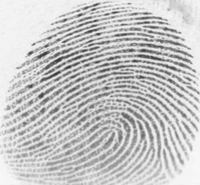The code of the human inner world lies on fingertips
Criminalists use fingerprints for identification. At that, every human and even each of monozygotic twins has their unique fingerprints.

Dermatoglyphics (from the Greek words ‘derma’ – skin, ‘glypho’ – engrave) is the science about patterns of fingerprints. Original crested patterns cannot be properly examined immediately on living people, so crime experts need fingerprints to be taken for a more convenient study.
Papillary patterns on the skin and ridged skin sectors are typical of Primates that have highly manipulative hands. Lower Primates – lemurs, Tupaia, tarsiers – grab items and tree branches in a rather simple way. So, they have patterns only on fingers and some sectors of palms. The oftener a primate catches items for closer study in various manners the more intricate skin patterns and more complex brain it has.
It is known that babies love to finger everything they can reach. It is a proven fact that active tactile experience of babies helps their higher nervous activity develop better and their brains get mature quicker at that. Ridged skin on fingers helps determine the texture of surfaces, their temperature, weight and other characteristics important for identification of objects. Flat surfaces of fingers read information about extensional characteristics of an object in a way contrary to the cartography principle. Ridged skin of human palms has lots of nerve cells susceptible to pressure and temperature.
It is known that ridge patterns form three classes: arches, loops and whorls. Loops are the most widespread pattern among people of European background. At least, every fourth human of the class has only loops. Whorls are typical of Mongoloids who have them on all fingers, and of Europeans who have whorls on thumbs and ring fingers only. So, it means that occurrence of patterns depends upon the race of a human being, every particular finger and upon pathologies of the central nervous system if there are some. At that, in case of pathologies, Down’s syndrome for example, patients have a particular complex of peculiarities of the skin pattern and others irrespective of their races.
There is no need to study the ridge pattern of children suffering from Down’s syndrome as the disease is quite obvious. But it is important that ridge patterns on fingers may help doctors determine if infants who have stuttering parents will also be stammers in the future when they begin to speak. It is often that stammering people have stammering children. Besides, a great number of stammers are left-handers. Families where both parents and children stammer are usually neurasthenic and psychasthenic which makes it difficult to get rid of the stammering defect. It is important to diagnose if a baby is an inborn stammer or not. It is quite clear that babies learn to speak and imitate the speaking manner of some of the parents and thus may learn to stammer if his mother or father stammers as well.
Majority of us are right-handers and usually have more ridges and more complex patterns on the right hand. And left-handers, as well as stammers, have distinct symmetry of patterns on both hands. At that, the difference between skin patterns on different fingers is insignificant among stammers.
Starting with very beginnings of the Homo genus, our ancestors were getting more independent of the environment thanks to improvement of the central nervous system, and the brain particularly, that guaranteed flexible behavior. This behavior in its turn allowed effective training. The universal type of adaptation to the environment made many of the essential class features neutral species peculiarities.
A wide variety, including racial, sexual and so on, is the species peculiarity of humans. At the same time, uniformity is typical of pathologies. Fingerprints are easy for getting that is why they were chosen for identification. However, any of the species peculiarities such as voice, handwriting, characteristic step and others may also be chosen for identification. If some peculiarity is constant among normal humans then it is a highly important specific feature.
There are loops and whorls on human fingers but there are none on the palms. On the contrary, toes have simple patterns while pads between the toes may also have patterns.
It is known that serial killers have very special fingerprints, but nobody knows how many of law-abiding men have similar skin patterns.
It is only in extreme cases that fingerprints may be an informative marker system, for example in professional sport where the selection is severe. Recently it was proved that a great number of both ridges and complex patterns were typical of sportsmen going in for sports requiring complex coordination. On the contrary, sportsmen who have to stand short-term ultimate load usually have simple loops with few ridges or only arches. But it is important to know that validity of prognoses based upon fingerprints of normal mentally healthy people seems dubious.
Aglaya Smirnova
Moscow University
Subscribe to Pravda.Ru Telegram channel, Facebook, RSS!




